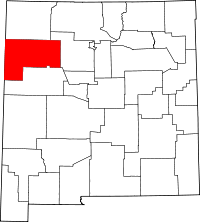Ramah Navajo Indian Reservation
The Ramah Navajo Indian Reservation is a non-contiguous section of the Navajo Nation lying in parts of west-central Cibola and southern McKinley counties in New Mexico, United States, just east and southeast of the Zuni Indian Reservation. It has a land area of 230.675 sq mi (597.445 km²), over 95 percent of which is designated as off-reservation trust land. According to the 2000 census, the resident population is 2,167 persons.[1] The Ramah Reservation's land area is less than one percent of the Navajo Nation's total area.
Although part of the Navajo Nation, the Ramah Navajo Indian Reservation has had an independent history from that of the other Navajo lands. The Ramah Navajo have been recorded in this area of New Mexico since 1540, when they came to the aid of the Zuni in their defense against the Spanish conquistador Francisco Vásquez de Coronado.
In the years from 1868 through the 1960s, the Ramah Navajo acted independently of the Navajo Nation. Although part of the Navajo Nation since the 1960s, they accomplished some "firsts." They founded the Pine Hill community with its Pine Hill Navajo School and health clinic. Community leaders, professionals, and Michael Gross, a lawyer from the East who had begun to work in legal services for Native Americans, obtained funding directly from the U.S. Congress in the early 1970s for the school and clinic.
Although the Ramah Band of Navajo had lived on their lands for several centuries up to the 1970s, their rights to them had not been fully secured under United States law since a transfer by the U.S. government had not occurred. The Navajo on these lands were not eligible for the services and benefits provided by the governmental agencies and departments to federally recognized tribes on trust lands.
In 1979, the volunteer, Jan Crull, Jr. succeeded, securing Public Law 96-333 .[2] He also taught the Ramah Navajo how to obtain all mineral rights underlying the lands he had secured for them with Public Law 97-434 . Crull's work led to his nomination by the Navajo for the Rockefeller Public Service Award in 1981, which was endorsed by U.S. senators Dennis DeConcini, Pete Domenici, and John Melcher; and U.S. congressmen Manuel Lujan, Jr. and Paul Simon.
Ramah Navajo Police Force
Ramah is unique from the rest of the Navajo Nation with having its own police force and police district along with its own new detention center scheduled to open in 2015.
Navajo Council Delegate
Ramah is represented by George Apachito of Ramah who is one of the 24 Council Delegates who represents the nations 110 Chapters. He also Represents the two other satellite Chapters of Alamo and Tohajilee.
Amended Navajo Flag
Currently Ramah is not represented on the Navajo Nation Flag, but the chapter has adopted an amended Version of the design which includes Ramah, Alamo, Nahata Dziil, Tohajilee, and Aneth Chapters which was adopted on July 16, 2014 by a Vote of 47 within the Ramah Navajo Chapter. The Crusader for this Campaign is Marlon Murphy Begay of Nahata Dziil who presented it with a Resolution. Ramah was the second Navajo Chapter to adopt this flag after Nahata Dziil (Sanders) on June 13, 2014
References
- ↑ Ramah Navajo Reservation (Tribal Census Tract 9458), Navajo Reservation and Off-Reservation Trust Land, Arizona/New Mexico/Utah United States Census Bureau
- ↑ John Melcher,chair. Select Committee on Indian Affairs,U.S. Senate Hearing: S. 1730, To Declare That Title To Certain Lands In The State Of New Mexico Are Held In Trust By The United States For The Ramah Band Of The Navajo Tribe , November 20, 1979. pp.: 268 Washington,D.C.: U.S. Government Printing Office 1980
External links
Coordinates: 34°50′47″N 108°22′46″W / 34.84639°N 108.37944°W

